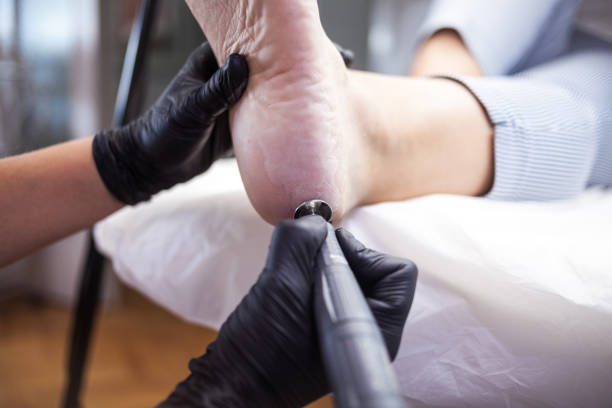Your feet are complex anatomical structures that support you throughout life. They can be prone to injury like fractures and sprains. You can also experience long-term issues like osteoarthritis, which may require medication or surgery.
When choosing a podiatrist, it’s important to find one with the right credentials. This includes education and hospital-based residency training.

1. Reputation
The intricate network of bones and nerves in your feet make them susceptible to a variety of medical problems. Whether it’s a short-term issue such as an ingrown toenail or a chronic condition such as diabetes, your podiatrist can help you get back on your feet.
A podiatrist can also diagnose the underlying cause of your foot problem, which makes treatment more effective. For example, if you have bunions, they can help prevent the deformity from getting worse by prescribing simple lifestyle changes that reduce pressure on the feet and ankles.
During your initial consultation with local podiatry clinic, their podiatrist will take a full history of your symptoms and any previous treatments or surgeries you’ve had for your foot issues. They’ll then carry out a comprehensive examination of your foot and ankle, looking at skin, nails, blood flow to your feet and lower legs and the way you walk and move.
A podiatrist can diagnose a variety of conditions that affect your feet, ankles and lower legs. They can prescribe medication for pain, advise you on exercise and weight management or refer you to a physical therapist for rehabilitation if necessary. A podiatrist can also provide you with orthotic inserts or shoes that will support your feet, help with balance and posture and treat heel pain. They can also deal with hammertoes, plantar fasciitis, warts, athlete’s foot and nail infections and sprains or fractures of the foot or ankle.
2. Convenience
Podiatrists treat a wide variety of foot, ankle and related problems. They treat common ailments like ingrown toenails, warts, athlete’s foot and hammertoes, and they also help patients with chronic conditions, such as diabetes or hypertension, that can affect their feet. They work closely with other medical professionals, including primary care physicians and physical therapists, to ensure comprehensive and coordinated healthcare for their patients.
Because the feet are essential for balance and mobility, they’re often the first part of the body to show signs of serious diseases and disorders. Visiting a podiatrist regularly is an important way to keep them in tip-top shape and avoid long-term problems.
While some podiatrists spend time performing surgery at a hospital, most of their practice takes place in private offices. This gives them more control over their schedules and allows them to spend more time with each patient. They may occasionally be required to respond to emergencies at the hospital, but they typically don’t have the same on call responsibilities as other physicians.
As people age, their feet can change and lead to problems like bunions. A podiatrist can evaluate the condition to determine if simple lifestyle changes could slow its progression. They may also recommend a orthotic treatment like inserts or shoe inserts and other treatments to prevent a bunion from getting worse and reduce pain. As the old saying goes, an ounce of prevention is worth a pound of cure.

3. Specialization
The human foot is a complex structure that balances, moves and supports our weight. It consists of 26 bones, muscles, ligaments and nerves. It also has a strong connection to the rest of our body and is the first part of the body to show signs of serious health problems, such as diabetes or heart disease. Because of the important role that our feet play, podiatrists specialize in diagnosing and treating problems of the feet and ankles.
A podiatrist is a physician with specialized training in the medical and surgical treatment of the foot, ankle and related structures. This includes making independent judgments, utilizing x-ray and laboratory tests for diagnostic purposes, prescribing medications, ordering physical therapy, setting fractures, and performing surgery when necessary.
Podiatrists have a deep understanding of how the health of your feet affects your overall health and are able to help you stay active. They also know that keeping your feet healthy helps you enjoy life and can help prevent foot issues from developing in the future.
If you have any inquiries regarding your foot health, don’t hesitate to reach out to a podiatrist today through this website: (https://talariapodiatrist.com.au/). Many podiatrists welcome opportunities for interviews, which can provide valuable mentoring or shadowing experiences for students interested in pursuing a career in this field. Their expertise makes them well-equipped to address various questions about the profession.
4. Experience
The human foot is an intricate structure that supports us through daily movement. It contains 26 bones, muscles, nerves and ligaments that are susceptible to a wide range of medical conditions. Because the feet have a direct relationship with the rest of the body, they are often the first area to show symptoms of diseases like diabetes and heart disease. This makes podiatrists a vital part of the medical community.
Podiatrists are trained to diagnose, treat and manage all types of foot and ankle conditions. They have experience with nail disorders, hammertoes (a bending deformity of the second through fifth toes) and other conditions that may affect your foot health.
They will evaluate the health of your feet and ankles and make recommendations for treatment, including topical medicines or surgery. They will also provide guidance on healthy foot care and exercise. They will be able to give advice on breathable footwear for sports and work, as well as offer professional fittings for orthotics.
As with all medical professions, the ability to communicate effectively is a key skill for podiatrists. They must be able to put their patients at ease and explain complex medical terms in a way that is easy for the layperson to understand. They must also be able to think critically and assess their patients’ needs with compassion.




